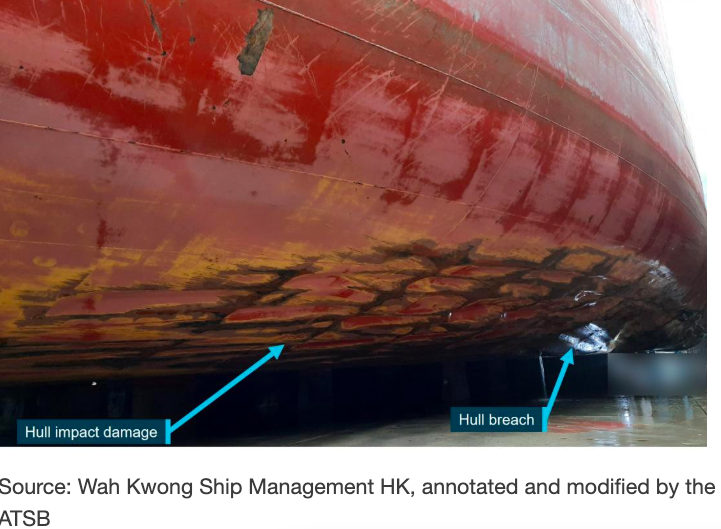Lessons Learned: Bulk Carrier Grounded by Short Circuit

ATSB (Australian Safety Transport Bureau) investigated an electrical short circuit that grounded a bulk carrier.
On April 9, 2022, the Liberian-flagged bulk carrier Hagen Oldendorff departed its berth with a harbor pilot on board and four tugs assisting for an outbound passage of Port Hedland’s 40 km dredged channel.
During the transit, shortly after completing a turn, an electrical short circuit led to the loss of power to all of the bulk carrier’s analogue rudder angle indicators.
Incorrectly believing the ship’s steering had failed, the bulk carrier’s bridge team implemented the relevant emergency response procedures for a steering failure.
Maneuvering orders issued during the response resulted in an uncontrolled turn to port, and a collision with the side of the channel at about 6.1 knots.
The ship was returned to the center of the channel, and taken out to anchorage, where inspection revealed it was taking on water in two of its double-bottom water ballast tanks, due to substantial damage which required extensive repairs.
Fortunately, no injuries or pollution were reported.
“Port Hedland is the largest bulk export port in the world, and a grounding in the channel could have significant outcomes not only for the environment and for the safety of those on board, but also for the Australian economy,” ATSB Chief Commissioner Angus Mitchell said.
As such, significant research has gone into the appropriate safety measures and procedures for ship movements in and out of Port Hedland.
“In any best practice, safety-critical operation, single points of failure should be eliminated,” Mr. Mitchell continued.
“In this instance an electrical short circuit led to the loss of power to all of the ship’s analogue rudder angle indicators.”
Watch the YouTube video of the bulk carrier
The ATSB’s final report notes Hagen Oldendorff’s rudder angle indicators were compliant with international regulations and classification society rules.
“However, these applicable rules and regulations did not, and still do not, require the ship’s rudder angle indicators be protected against a single point of failure, such as the tripping of the common circuit breaker, which in this case resulted in a loss of electrical power supply to all the analogue indicators,” Mr. Mitchell said.
“Additionally, the rules do not require installation of audible or visual alerts to notify the bridge team of a loss of power supply affecting the indicators.”
As such, the ATSB has issued a safety recommendation to Hagen Oldendorff’s flag state administration, the Liberia Maritime Authority, as well as the ship’s classification society, Lloyd’s Register, and Australia’s maritime regulator, the Australian Maritime Safety Authority, to address the risk associated with a single point of failure in electrical power supply for ship rudder angle indicators.
“While some progress has been made towards resolving this safety issue, there is an absence of detailed proposals and a timeframe to resolve it,” Mr. Mitchell said.
The ATSB’s investigation also found the ship’s pilot had cast off the port and starboard shoulder tugs early, inconsistent with the recommended practices of Port Hedland’s escort towage strategy.
“Further, the investigation identified that best practice escort towage guidance was not integrated into the Port Hedland port user guidelines and procedures, or into the pilotage provider’s safety management system,” Mr. Mitchell noted.
In response to the incident, the Pilbara Ports Authority updated its user guidelines and procedures to incorporate tug retention and utilization practices, and guidance recommended in the port’s escort towage strategy.
Additionally, the pilotage provider, Port Hedland Pilots, advised the ATSB that its pilots now keep the forward two tugs fast, as recommended, for the relevant channel sections, unless prevented from doing so by weather or other factors.
“Pilotage and towage are primary risk control measures in ensuring the safety of port operations,” Mr. Mitchell concluded.
“Where demonstrated techniques and practices have been identified that increase the effectiveness of towage in preventing incidents, and in mitigating the consequences when they occur, it is imperative that they are appropriately documented, disseminated, and implemented.”
Content/photo source/credit: ATSB, “ATSB safety recommendations seek to eliminate single point of failure following bulk carrier grounding,” published 12/20/2024.



